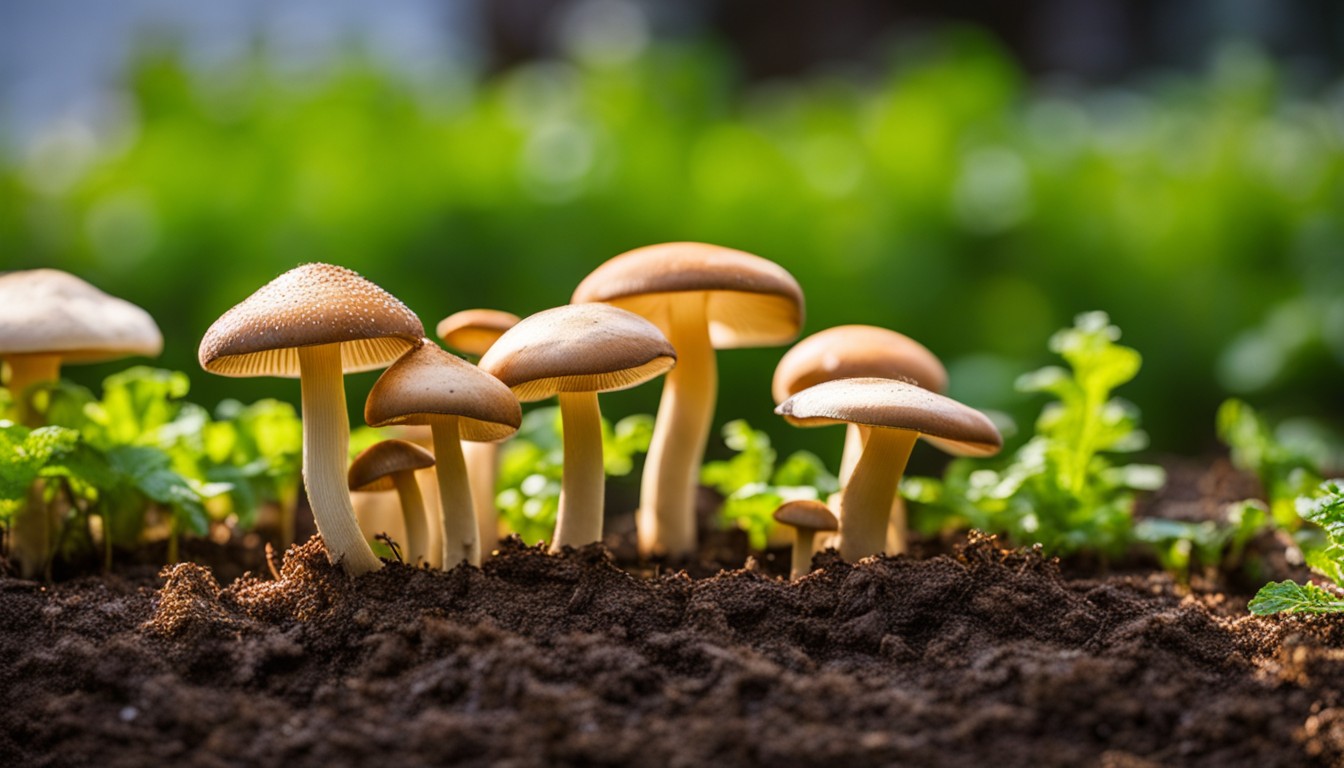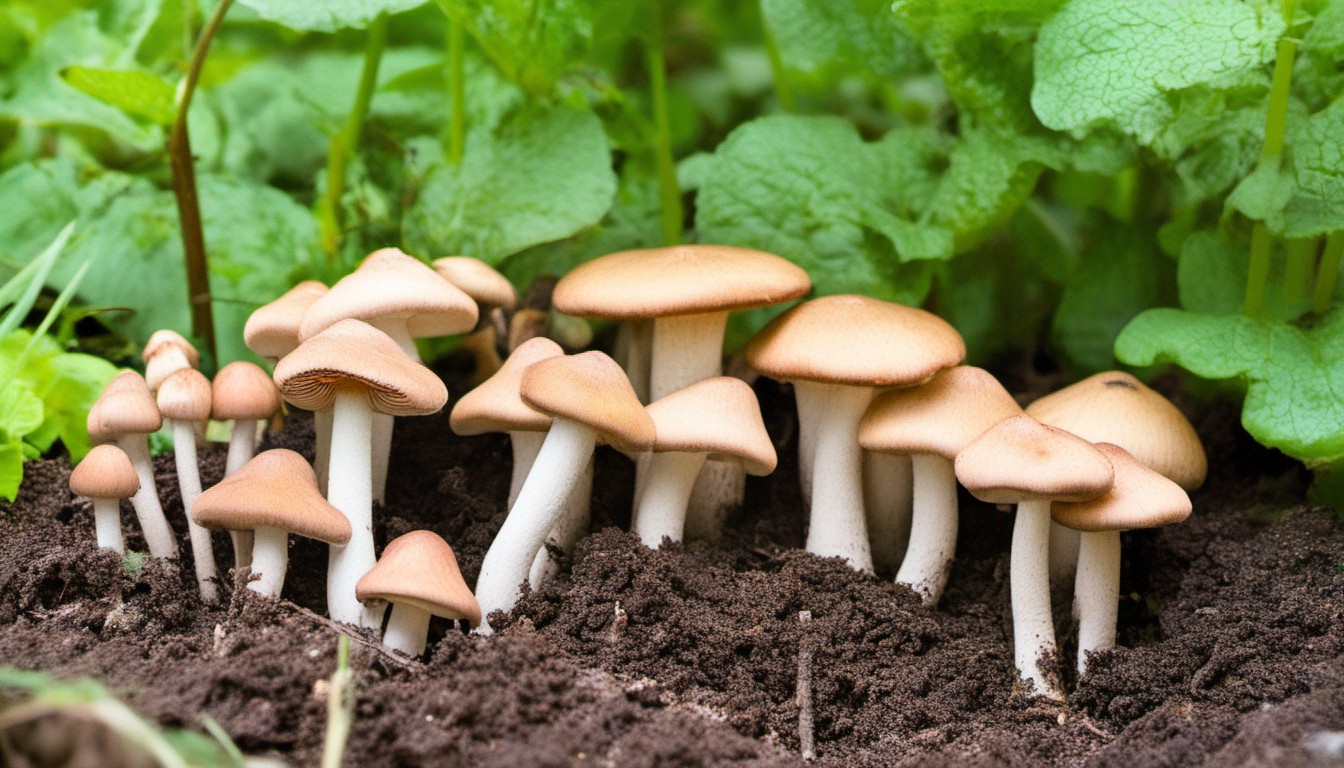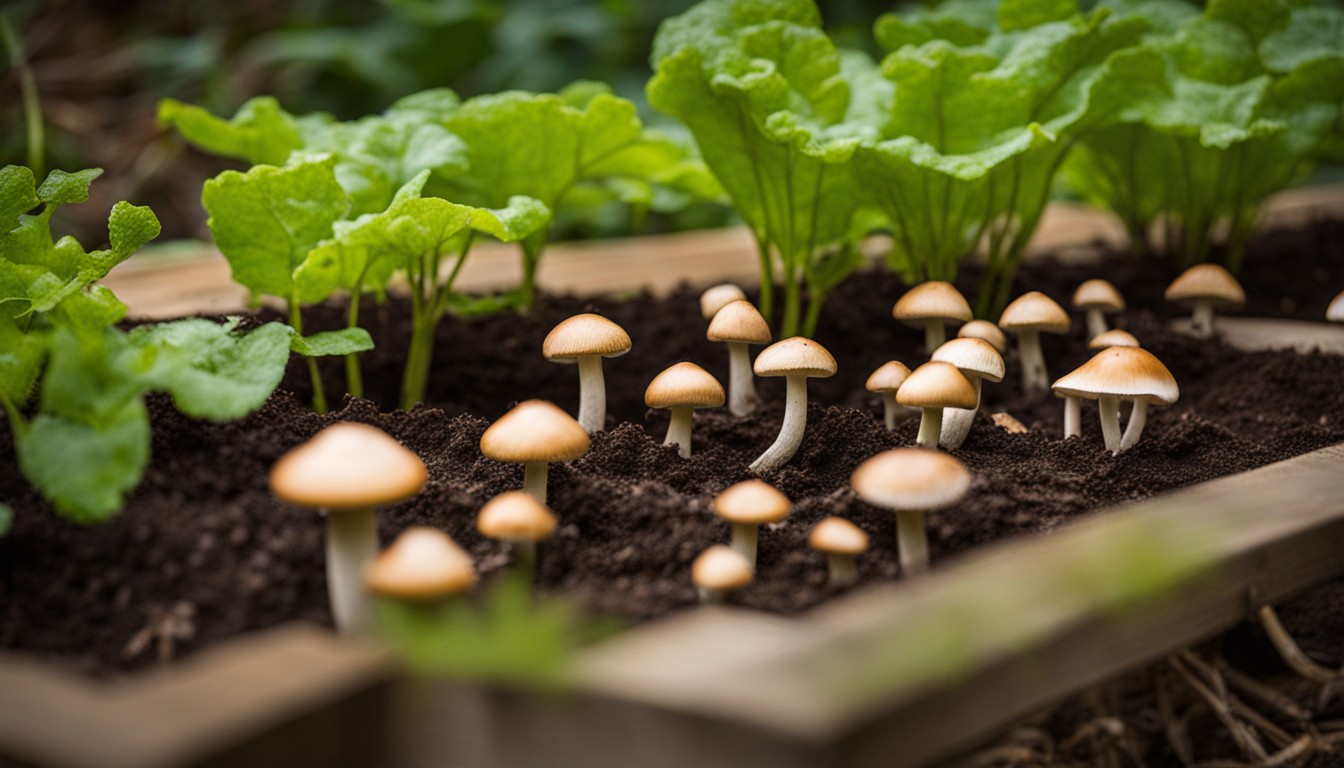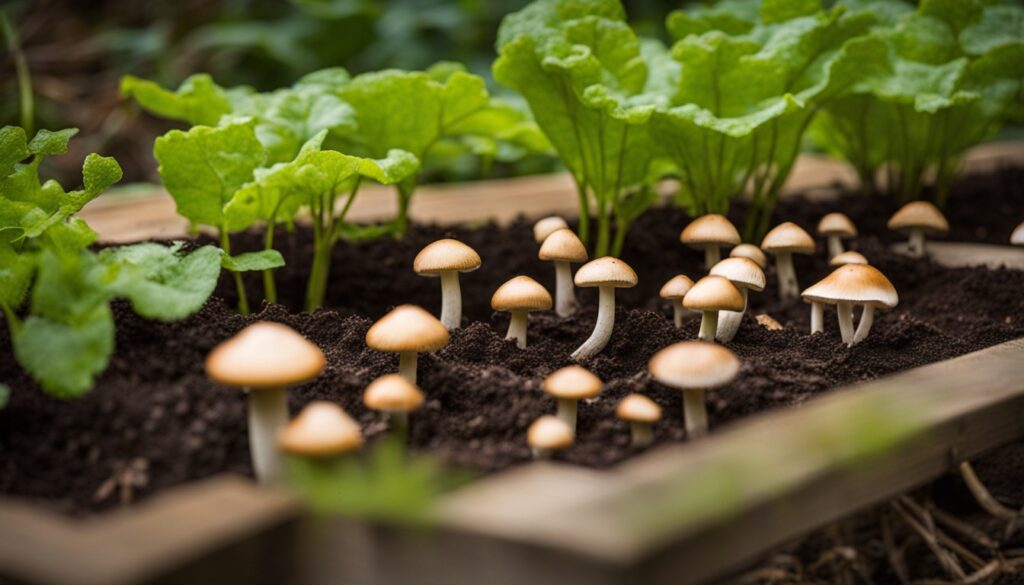Are you interested in growing your own mushrooms in a raised garden bed? This informative guide will walk you through the step-by-step process of cultivating mushrooms, from choosing the right type of mushrooms to preparing the soil in your raised garden bed. Discover the benefits of growing mushrooms in a raised bed and learn about the different varieties of mushrooms that thrive in this environment. Whether you are a seasoned gardener or a beginner, this guide will provide you with all the information you need to successfully grow mushrooms in your outdoor space. Get ready to embark on a fascinating journey into the world of fungi and enjoy the rewards of cultivating your own mushrooms at home.
Selecting the Right Mushroom Varieties
Assessment of ideal mushroom varieties for an outdoor space is essential. Diversity in species, coupled with understanding your climate and soil structure, will determine fungi that’ll flourish perfectly.
In selecting mushrooms for your raised garden bed, key factors like your environmental conditions, mushroom’s cultivation requirements and intended use, whether for culinary or decorative purposes, should guide your choices. A well-researched selection adapts better to your garden bed and improves overall yield.
Consider Your Climate
Climate significantly impacts your mushroom cultivation efforts, for the conditions in your geographical region dictate which mushroom varieties will thrive. Investing time in understanding the relationship between your local climate and mushroom cultivation is crucial for success.
- Temperature ranges appropriate for various mushroom species
- Humidity levels needed for optimal growth
- Seasonal changes that could affect mushroom cultivation
- The role of precipitation in mushroom growth
Choosing Edible or Decorative Mushrooms
The decision to grow edible or decorative mushrooms largely depends on your purpose and the overall aesthetic you envision for your garden. Culinary lovers, for example, might gravitate towards edible varieties, while those looking for an aesthetic boost might opt for charming, decorative species.
- Culinary benefits: Edible mushrooms such as Shiitake, Oyster, and Portobello offer exquisite flavors.
- Aesthetic benefits: Decorative mushrooms like the vibrant Fly Agaric or the intriguing Bird’s Nest fungi can boost the visual appeal of your garden.
- Edible and decorative: Certain mushrooms such as the edible and visually appealing Lion’s Mane provide the best of both worlds.
Researching Mushroom Cultivation Requirements
To ensure the success of mushroom cultivation in a raised garden bed, understanding the growth habits and needs of chosen varieties is crucial. Examining specific culture requirements is an essential task before embarking on mushroom farming.
- The substrate preference of different mushroom types
- Lighting conditions optimal for each variety
- Ideal temperature and humidity levels for growth
- Span of the growth cycle
- Potential disease susceptibility and prevention methods
Preparing the Raised Garden Bed

Identifying the ideal sunny or partially shaded location forms the first key step in prepping your raised garden bed for mushroom cultivation. Follow up with the selection or construction of a durable, ideally wooden, raised garden bed, taking into consideration the depth to complement the types of mushrooms you intend to grow.
Properly preparing a raised garden bed can increase the yield and quality of mushroom cultivation by controlling soil composition and providing optimal growth conditions.
Attention to soil preparation can prove pivotal. Mix in the right composition of organic matter, compost, and even non-compacted straw. After laying the chosen mushroom spawn, providing ample moisture controls and protection against pests and diseases ensures the conducive environment crucial to successful mushroom cultivation.
Selecting the Ideal Location
The orientation of sunlight affects the growth of mushrooms significantly. A strategic position for your raised garden bed is crucial for optimal mushroom cultivation
- North-facing garden beds provide more shade which is ideal as mushrooms thrive in cool, damp conditions.
- Avoid placing the garden bed under direct sunlight as it can dry out the soil and harm the mushroom mycelium.
- Consider spaces which are naturally shaded or partially shaded by tall trees or buildings.
- Mushroom beds need some protection from the weather, so consider locations with a canopy or shield from extreme weather.
Building or Buying a Raised Garden Bed
When it comes to building or purchasing a raised garden bed suitable for mushroom cultivation, one must conduct a comparative analysis. Understanding the pros and cons of a DIY versus a store-bought setup plays a crucial role in choosing the right option.
- DIY raised beds offer customization, catering to the specific requirements of mushroom farming, but they may require significant time and effort.
- Store-bought beds save time and offer convenience, though they might lack some customization options necessary for optimized fungus growth.
- Considerations like drainage provisions, protective barriers against pests, and a conducive environment for fungi need to be factored in while choosing between DIY and store-bought options.
Preparing the Soil
The bed soil’s characteristics play an instrumental role in mushroom cultivation. It should possess an optimal balance of pH, nutrient content, and moisture retention capability, tailored to the specific mushroom variety.
Implementing sustainable soil replenishment practices will boost the productivity of your mushroom garden bed. This includes adding rich compost and reinvigorating the soil with additional mushroom spawn every growing season.
Paying attention to these soil requirements and practices can provide an environment conducive to robust mushroom growth. Over time, this will lead to a bountiful, sustainable harvest of mushrooms from your raised garden bed.
Sourcing Mushroom Spawn

Successfully cultivating mushrooms starts with sourcing high-quality spawn. Unmasking reputable suppliers through online and offline resources is crucial to procure viable and genuine mushroom spawn.
The importance of sourcing mushroom spawn is heightened by factors such as genuineness and viability. Ensuring the legitimacy of the source and the liveliness of the spawn leads to a successful mushroom cultivation venture.
Understanding Spawn Types
Grain, sawdust, and woodchip spawns differ primarily in their substrate. Grain spawn, usually barley, rye or millet, is favoured for its speed and high colonization rate. Sawdust spawn, made from sterilized wood, is beneficial for larger quantities or outdoor use, appreciated for its cost-effectiveness and rapid growth.
In contrast, wood chip spawn, although slower in colonization, thrives outdoors, particularly when introduced into logs or stumps. It’s ideal for wood-loving mushroom species, ensuring an extended, substantial yield.
The type of mushroom spawn can significantly influence your yield and its growth rate. Grain spawn often results in a quicker harvest but may not provide as many fruiting cycles. Sawdust and wood chip spawns, on the other hand, take longer but yield larger crops over a more extended period.
Remember, what works best largely depends on the specific mushroom variety you wish to cultivate, your gardening environment and personal preference. Correct type of spawn ensures a healthy, abundant mushroom harvest and enriches your gardening experience.
Purchasing Quality Spawn
Quality matters when purchasing mushroom spawn, its caliber directly impacts the health and yield of your fungi. A superior spawn brings an abundant and consistent harvest, whereas an inferior product may lead to poor growth or adverse effects.
Scrutinizing the various spawn types can be pivotal. Each variety has its durability and efficiency in mushroom cultivation. Some spawn types may thrive in certain environmental conditions while floundering in others.
Always invest in quality spawn from reliable sources. Your mushroom garden’s success hinges on it. An investment, indeed, but the resulting bounty of robust, healthy mushrooms will validate your decision.
Planting and Caring for Mushroom Spawn
Supplying the right balance of nutrients is fundamental to nurturing healthy mushroom spawn. This includes a blend of organic matter — containing nitrogen, carbon, and trace minerals — which fuels the growth and fruiting of the fungi.
It’s crucial to recognize signs of an unhealthy mushroom spawn such as slow growth, off-color, and untypical odors. These indications typically signal inadequate growing conditions or potential contamination, warranting immediate attention and modification in mushroom care.
Planting Techniques
Although planting techniques may vary with the type of mushroom, the underlying principle is the correct introduction of spawn into the soil for optimum growth. The incorporation of inoculated grains or plugs into the substrate aids in the establishment of a robust mycelium network, central to abundant mushroom production.
To maximize yield, adopt a layered planting approach. A mixture of spawn and compost applied as separate layers interjected by a casing layer of nutrient-rich soil encourages vigorous mushroom growth. This multi-tier strategy promotes an extensive network of fungal threads, fostering a garden flush with gourmet mushrooms.
Proper Moisture and Temperature Control
Mushroom cultivation is both a science and an art, relying significantly on optimal moisture and temperature conditions. Different species gather their nutrients from the environment differently, requiring specific humidity ranges and temperatures. For instance, while some fungi prefer cooler, moist environments, others thrive in warmer, drier scenarios.
The process of maintaining a consistent temperature in your raised garden bed is crucial for the mushroom’s mycelial network. It’s paramount to understand that certain species need different temperature ranges to grow. For instance, Shiitake mushrooms thrive when temperatures range from 55-60 Fahrenheit, while Oyster mushrooms prefer a warmer climate at 65-75 degrees.
Assuring an ideal level of moisture is equally important, as excess or insufficient water can hinder mushroom growth. Therefore, striking a balance is crucial. While certain species like Shiitake mushrooms enjoy humidity levels of 80-90%, others like the White Button prefer slightly lower levels of around 70-75%.
To facilitate optimal growth, modern technology offers gardening gadgets for precise control and monitoring of your garden’s conditions. Tools like soil moisture sensors, digital thermometers, and humidity monitors can help create the perfect environment for your mushrooms to thrive. Investing in these automated instruments can significantly improve your mushroom cultivation success.
Tech advancements have also led to the development of smart gardening systems, enabling automated control of temperature and moisture. These sophisticated systems, coupled with understanding the specific needs of your chosen mushroom variety, can transform any raised garden bed into a thriving mushroom farm. Always remember, balance is key: overly dry or wet conditions can inhibit mushroom growth.
Protection from Pests and Diseases
The health of your mushrooms can be significantly influenced by a proactive approach to pest and disease management, including simple gardening techniques like regular checks for signs of disease or pests. Implementing these preventive measures can preemptively safeguard your fungal treasures from common threats.
Recognizing the beneficial roles of certain insects and other predators in your garden ecosystem is also crucial in maintaining a thriving mushroom bed. These natural pest predators can help eliminate threats to your mushrooms.
Regular application of organic antifungal treatments, combined with proper sanitation practices, can add another layer of protection for your mushroom garden, further reducing the risk of diseases and pest infestations.
Harvesting and Storing Mushrooms

A keen eye is required when determining the best time to harvest various mushroom species in your raised garden bed. The nurturing measures taken also significantly influence this, as factors like maintaining optimal soil moistness and providing adequate shade could hasten the fruiting stage of your fungi.
Harvesting mushrooms is somewhat an art in itself, requiring precise and careful techniques. Employ a practical approach in reducing damage during the process, possibly by using mushroom picking tools for cleaner cuts or brushing off excess soil gently. For storage, opt for a cool, dry place to prolong the freshness, or employ preservation techniques like canning or drying for long-term use. These practices ensure you enjoy the natural goodness of your homegrown mushrooms for extended periods.
Signs of Readiness for Harvest
Assessing the physical maturity of your mushrooms is critical in determining their readiness for harvest. Look for visible signs such as the flattening of the mushroom cap, or for gilled mushrooms, when they start to turn upwards.
Understanding the growth pace of your chosen mushroom variety can provide valuable insights into when they are ripe for harvest. A sudden change in growth pace or form typically indicates that it’s time to collect your mushrooms.
Harvesting Techniques
Recognizing the diversity among mushroom species is pivotal to adopting viable harvesting techniques. Different fungi possess unique traits and growth patterns which should dictate your harvest strategy, from careful hand-picking to using specialized tools.
The longevity of your mushroom productivity significantly hinges on the employed harvesting techniques. Inappropriate or harsh harvesting may damage mycelium, compromising future crops. As such, a gentle and respectful approach is vital to ensure continuous yields.
Further, your harvesting method directly influences the mushroom’s quality post-harvest. Techniques that minimize contact with the fruiting body, such as twisting and pulling, promise to deliver mushrooms in pristine condition, thereby extending shelf-life and maintaining aesthetic appeal.
Proper Storage and Preservation
Storing mushrooms requires diligence in maintaining optimum conditions; temperature should sit between 30°F to 35°F with relative humidity at 95%. Deviating from these parameters may shorten their shelf life and degrade quality. Effective use of refrigeration and proper packaging can help to avoid this.
Improper storage poses significant implications for mushroom quality, potentially inducing unwanted flavor changes, texture softening, and recoloring. To avoid such complications, store mushrooms in breathable packaging in the refrigerator, ensuring no moisture condensation, which could prompt fungal growth.
Frequently Asked Questions
Growing Mushrooms in Raised Garden Beds: Answers to Your Queries
Q: What are the advantages of growing mushrooms in a raised garden bed?
A: Growing mushrooms in a raised garden bed offers several advantages. Firstly, it provides better control over key factors like moisture, drainage, and temperature, creating an optimal environment for mushroom cultivation. Additionally, the elevated nature of raised beds helps to minimize the risk of contamination and makes harvesting mushrooms easier.
Q: Can any type of mushroom be grown in a raised garden bed?
A: While many varieties of mushrooms can be grown in a raised garden bed, certain species like oyster mushrooms and shiitake mushrooms are particularly well-suited for this type of environment. These mushrooms thrive in the conditions provided by raised beds, making them a popular choice for cultivation.
Q: How do I prepare the soil in a raised garden bed for mushroom cultivation?
A: To prepare the soil in a raised garden bed for mushroom cultivation, it is essential to create a nutrient-rich substrate. Start by enriching the soil with organic matter like compost or well-rotted manure. Next, add materials such as straw, wood chips, or sawdust to create a suitable growing medium for mushrooms. The substrate should be properly mixed and moistened before introducing mushroom spawn.
Q: What are some common challenges or problems when growing mushrooms in raised garden beds?
A: While growing mushrooms in raised garden beds can be rewarding, it does come with its own set of challenges. Common issues include maintaining proper moisture levels, preventing contamination from competing fungi or bacteria, and managing pests. However, with careful attention to detail and proper maintenance, these challenges can be overcome.
Q: How long does it take for mushrooms to grow in a raised garden bed?
A: The time it takes for mushrooms to grow in a raised garden bed can vary depending on the species, environmental conditions, and the specific mushroom variety being cultivated. On average, mushrooms can be harvested in as little as a few weeks to a few months after the introduction of mushroom spawn.
Q: Are raised garden beds suitable for year-round mushroom cultivation?
A: Raised garden beds can be utilized for year-round mushroom cultivation, provided that appropriate measures are taken to maintain the necessary temperature and humidity conditions. Some mushroom varieties are better suited for specific seasons, so it is important to choose the right varieties for continuous cultivation throughout the year.
Q: Can I use store-bought mushroom spawn for growing mushrooms in a raised garden bed?
A: Yes, using store-bought mushroom spawn is a convenient and reliable way to start your mushroom cultivation journey in a raised garden bed. Mushroom spawn can be purchased from reputable suppliers and usually comes with detailed instructions on how to use it effectively for successful mushroom growth.
Q: Are there any safety precautions to consider when growing mushrooms in a raised garden bed?
A: When growing mushrooms in a raised garden bed, it is important to take some safety precautions. Always wear gloves when handling mushroom spawn to prevent contamination. Additionally, ensure that the mushrooms you are cultivating are safe for consumption by consulting reputable sources or local experts for guidance.
Q: Can I grow mushrooms in a raised garden bed if I live in a different climate?
A: Yes, mushrooms can be grown in raised garden beds in various climates. However, it may be necessary to adjust the growing conditions and choose mushroom varieties that are suitable for your specific climate. Researching regional mushroom varieties and consulting local experts can help you determine the best mushrooms to grow in your climate.
Q: Are there any specific maintenance tasks required for growing mushrooms in a raised garden bed?
A: Regular maintenance tasks are essential for successful mushroom cultivation in raised garden beds. These tasks include monitoring moisture levels to ensure consistent humidity, inspecting the beds for pests or diseases, providing proper ventilation, and removing any decaying organic matter. Following a consistent maintenance routine will increase the chances of a bountiful and healthy mushroom harvest.
Conclusion
Cultivating mushrooms in a raised garden bed is a remarkable step in your journey to food self-sufficiency and sustainability. Remember, the key is selecting mushroom varieties suitable for your climate and whether they are edible or decorative. Understanding their cultivation requirements, preparing your garden bed with care, sourcing quality spawn, and providing proper care post-planting is crucial. Furthermore, mastering the signs that your mushrooms are ready for harvest, learning the correct harvesting techniques, and understanding the proper storage methods can contribute significantly to your success.
- Consider your local climate for suitable mushroom types
- Choose either edible or decorative mushrooms based on your gardening goals
- Research mushroom cultivation requirements
- Prepare your garden bed with the appropriate soil
- Source high-quality mushroom spawn
- Master the planting and care techniques
- Learn to identify when mushrooms are ready for harvest
- Know the proper harvesting techniques
- Understand the correct methods for storing and preserving mushrooms

